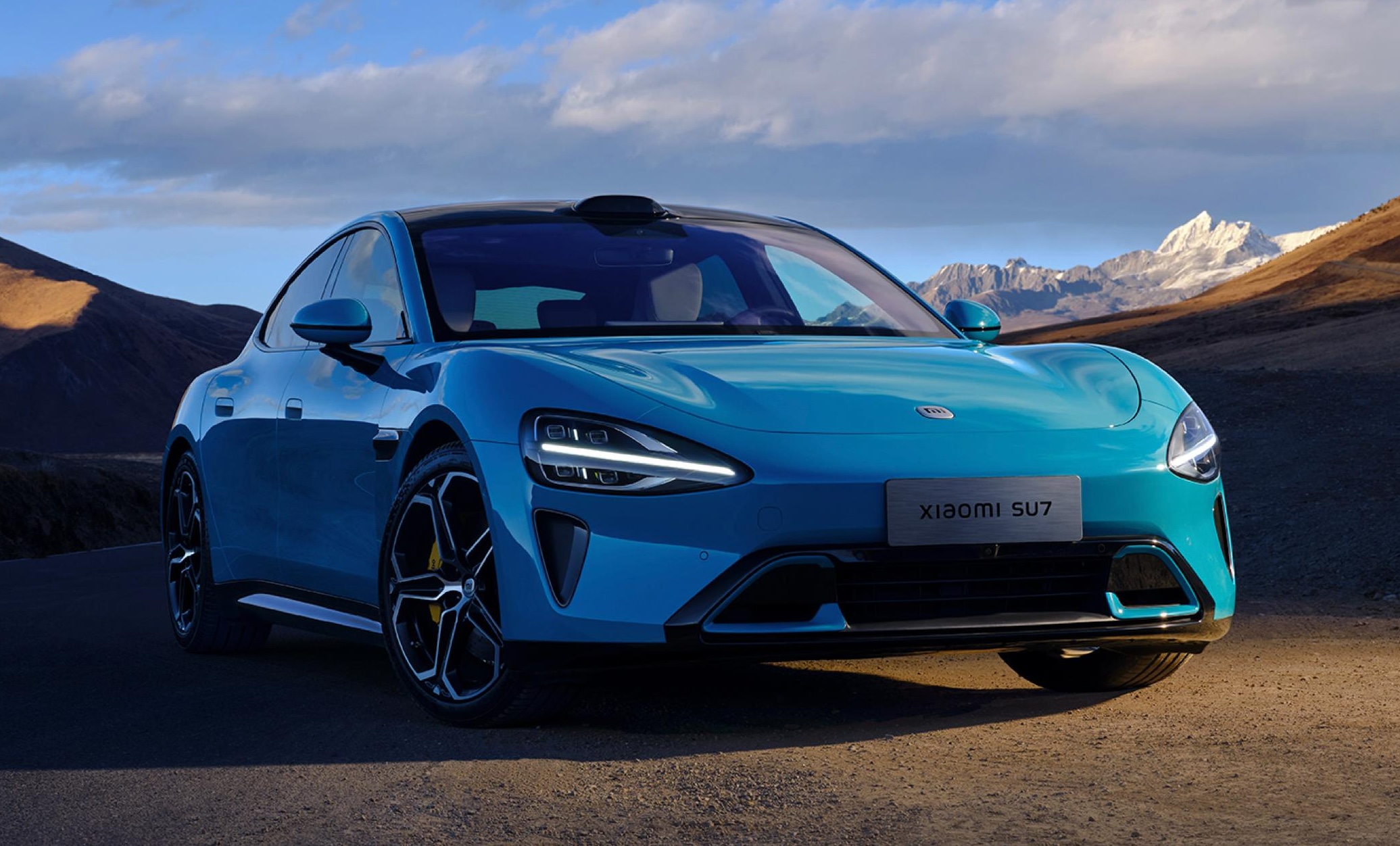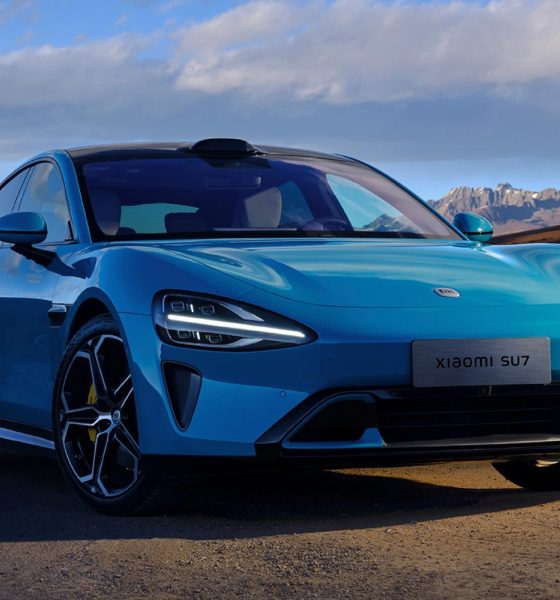In the smartphone world, Xiaomi is considered by some to be the “Apple of China” due to its devices’ features and overall quality. And with the launch of the Xiaomi SU7, it appears that the smartphone giant is also looking to achieve the title of “Tesla of China.”
At a launch event in Beijing, Xiaomi formally launched its first vehicle, the SU7 all-electric sedan. Three variants of the SU7 are offered for now — the SU7 Standard, SU7 Pro, and SU7 Max. The vehicles are competitively priced, with the SU7 Standard starting at RMB 215,900 ($29,870), the SU7 Pro starting at RMB 245,900 ($34,000), and the SU7 Max starting at RMB 299,900 ($41,500).
#XiaomiSU7 offers a variety of customization options, allowing you to create a driving mode that perfectly suits you. #XiaomiEVLaunch #DrivingForward pic.twitter.com/cwe4PVbSYQ— Xiaomi (@Xiaomi) March 28, 2024
For context, the upgraded Tesla Model 3 Rear Wheel Drive (RWD) starts at RMB 245,900 ($34,000) and the Model 3 Long Range Dual Motor All Wheel Drive (AWD) starts at RMB 285,900 ($39,500) in China. At such prices, the SU7 effectively undercuts the Model 3 by about $4,000 in price, with the midrange variant of Xiaomi’s all-electric car costing the same as Tesla’s entry-level Model 3.
Safety is an essential part of #XiaomiSU7. This car features our steel-aluminum alloy armored cage for unmatched protection.
Every SU7 is equipped with 16 active safety configurations, giving you complete peace of mind on the road. #XiaomiEVLaunch #DrivingForward pic.twitter.com/WbxAcldiIc— Xiaomi (@Xiaomi) March 28, 2024
During the Xiaomi SU7’s launch event, Lei Jun, founder, chairman and CEO of the smartphone giant, noted that the all-electric sedan is targeting the same customers as the Tesla Model 3. “Many people ask me who the Xiaomi SU7 is built for. My answer is, ‘Isn’t it time for Tesla Model 3 users to upgrade?’” the executive noted.
#XiaomiSU7 Max lets you drive back onto the road with an incredible 510 kilometers of range in just 15 minutes of charging.
Even the standard SU7 isn't far behind, offering a 350-kilometer range boost in the same timeframe. #XiaomiEVLaunch #DrivingForward pic.twitter.com/9XkDfBKazH— Xiaomi (@Xiaomi) March 28, 2024
The Xiaomi SU7 was benchmarked against the Tesla Model 3, and it shows. As per the executive, the SU7 is better than the Model 3 on over 90% of its specifications. The Xiaomi SU7 is slightly larger than the Model 3, and its starting range of 700 kilometers (almost 435 miles) is higher than the base Model 3’s 606 kilometers. Lei admitted, however, that it would probably take Xiaomi 3-5 years to catch up to Tesla in terms of powertrain efficiency.
Our smart cabin features five top-of-the-line screens. Whether it's connecting your smartphone to your car or your car to your home, #XiaomiHyperOS ensures a seamless and smooth experience.#XiaomiSU7 #XiaomiEVLaunch #DrivingForward pic.twitter.com/td0f1i6P92— Xiaomi (@Xiaomi) March 28, 2024
The reception of Chinese consumers to the SU7 has been very positive so far. In the first 27 minutes after the company started accepting orders for the vehicle, Xiaomi was able to secure over 50,000 firm orders. Deliveries of the SU7’s “Founders Edition” are expected to begin on April 3, 2024.
Le Jun is a true Tesla fan, one of the early Model S owners in China. pic.twitter.com/paU6Eyt3Qt— Ray (@ray4tesla) March 28, 2024
While the Xiaomi SU7 is undoubtedly an impressive all-electric sedan, it should be noted that Tesla is a very difficult target to catch because the company just refuses to stay still. This is hinted at by the Cybertruck, whose key innovations like its 48V architecture and steer-by-wire system will likely trickle down to the company’s later vehicles. With this in mind, Xiaomi may find itself competing against a company that’s determined to prove that the “Tesla of China” is still Tesla.
Don’t hesitate to contact us with news tips. Just send a message to simon@teslarati.com to give us a heads up.

News
Tesla FSD fleet is nearing 7 billion total miles, including 2.5 billion city miles
As can be seen on Tesla’s official FSD webpage, vehicles equipped with the system have now navigated over 6.99 billion miles.

Tesla’s Full Self-Driving (Supervised) fleet is closing in on almost 7 billion total miles driven, as per data posted by the company on its official FSD webpage.
These figures hint at the massive scale of data fueling Tesla’s rapid FSD improvements, which have been quite notable as of late.
FSD mileage milestones
As can be seen on Tesla’s official FSD webpage, vehicles equipped with the system have now navigated over 6.99 billion miles. Tesla owner and avid FSD tester Whole Mars Catalog also shared a screenshot indicating that from the nearly 7 billion miles traveled by the FSD fleet, more than 2.5 billion miles were driven inside cities.
City miles are particularly valuable for complex urban scenarios like unprotected turns, pedestrian interactions, and traffic lights. This is also the difference-maker for FSD, as only complex solutions, such as Waymo’s self-driving taxis, operate similarly on inner-city streets. And even then, incidents such as the San Francisco blackouts have proven challenging for sensor-rich vehicles like Waymos.
Tesla’s data edge
Tesla has a number of advantages in the autonomous vehicle sector, one of which is the size of its fleet and the number of vehicles training FSD on real-world roads. Tesla’s nearly 7 billion FSD miles then allow the company to roll out updates that make its vehicles behave like they are being driven by experienced drivers, even if they are operating on their own.
So notable are Tesla’s improvements to FSD that NVIDIA Director of Robotics Jim Fan, after experiencing FSD v14, noted that the system is the first AI that passes what he described as a “Physical Turing Test.”
“Despite knowing exactly how robot learning works, I still find it magical watching the steering wheel turn by itself. First it feels surreal, next it becomes routine. Then, like the smartphone, taking it away actively hurts. This is how humanity gets rewired and glued to god-like technologies,” Fan wrote in a post on X.
News
Tesla starts showing how FSD will change lives in Europe
Local officials tested the system on narrow country roads and were impressed by FSD’s smooth, human-like driving, with some calling the service a game-changer for everyday life in areas that are far from urban centers.

Tesla has launched Europe’s first public shuttle service using Full Self-Driving (Supervised) in the rural Eifelkreis Bitburg-Prüm region of Germany, demonstrating how the technology can restore independence and mobility for people who struggle with limited transport options.
Local officials tested the system on narrow country roads and were impressed by FSD’s smooth, human-like driving, with some calling the service a game-changer for everyday life in areas that are far from urban centers.
Officials see real impact on rural residents
Arzfeld Mayor Johannes Kuhl and District Administrator Andreas Kruppert personally tested the Tesla shuttle service. This allowed them to see just how well FSD navigated winding lanes and rural roads confidently. Kruppert said, “Autonomous driving sounds like science fiction to many, but we simply see here that it works totally well in rural regions too.” Kuhl, for his part, also noted that FSD “feels like a very experienced driver.”
The pilot complements the area’s “Citizen Bus” program, which provides on-demand rides for elderly residents who can no longer drive themselves. Tesla Europe shared a video of a demonstration of the service, highlighting how FSD gives people their freedom back, even in places where public transport is not as prevalent.
What the Ministry for Economic Affairs and Transport says
Rhineland-Palatinate’s Minister Daniela Schmitt supported the project, praising the collaboration that made this “first of its kind in Europe” possible. As per the ministry, the rural rollout for the service shows FSD’s potential beyond major cities, and it delivers tangible benefits like grocery runs, doctor visits, and social connections for isolated residents.
“Reliable and flexible mobility is especially vital in rural areas. With the launch of a shuttle service using self-driving vehicles (FSD supervised) by Tesla in the Eifelkreis Bitburg-Prüm, an innovative pilot project is now getting underway that complements local community bus services. It is the first project of its kind in Europe.
“The result is a real gain for rural mobility: greater accessibility, more flexibility and tangible benefits for everyday life. A strong signal for innovation, cooperation and future-oriented mobility beyond urban centers,” the ministry wrote in a LinkedIn post.
News
Tesla China quietly posts Robotaxi-related job listing
Tesla China is currently seeking a Low Voltage Electrical Engineer to work on circuit board design for the company’s autonomous vehicles.

Tesla has posted a new job listing in Shanghai explicitly tied to its Robotaxi program, fueling speculation that the company is preparing to launch its dedicated autonomous ride-hailing service in China.
As noted in the listing, Tesla China is currently seeking a Low Voltage Electrical Engineer to work on circuit board design for the company’s autonomous vehicles.
Robotaxi-specific role
The listing, which was shared on social media platform X by industry watcher @tslaming, suggested that Tesla China is looking to fill the role urgently. The job listing itself specifically mentions that the person hired for the role will be working on the Low Voltage Hardware team, which would design the circuit boards that would serve as the nervous system of the Robotaxi.
Key tasks for the role, as indicated in the job listing, include collaboration with PCB layout, firmware, mechanical, program management, and validation teams, among other responsibilities. The role is based in Shanghai.
China Robotaxi launch
China represents a massive potential market for robotaxis, with its dense urban centers and supportive policies in select cities. Tesla has limited permission to roll out FSD in the country, though despite this, its vehicles have been hailed as among the best in the market when it comes to autonomous features. So far, at least, it appears that China supports Tesla’s FSD and Robotaxi rollout.
This was hinted at in November, when Tesla brought the Cybercab to the 8th China International Import Expo (CIIE) in Shanghai, marking the first time that the autonomous two-seater was brought to the Asia-Pacific region. The vehicle, despite not having a release date in China, received a significant amount of interest among the event’s attendees.










